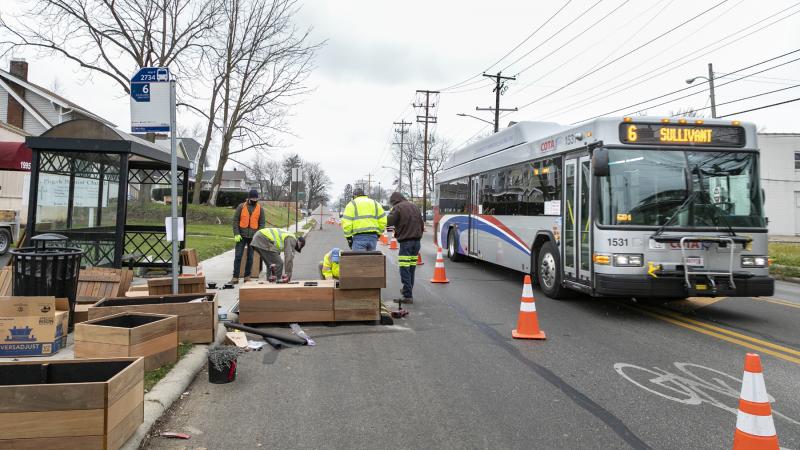Knowlton Students Design First Bus Stop Parklet in Columbus
Installation of Central Ohio’s first bus stop parklet was completed along Sullivant Avenue in December, the culmination of a semester-long collaboration between Ohio State Landscape Architecture students, the Neighborhood Design Center, the Central Ohio Transit Authority (COTA), and the City of Columbus Department of Public Service. Designed to revitalize and beautify Sullivant Avenue, the semi-permanent sidewalk extension features park-like amenities such as planter boxes and seating.
COTA initiated the project by asking the Neighborhood Design Center to host a design seminar with Knowlton School landscape architecture students. The primary objective was to design three distinct parklets to enhance the experience of transit users, with the locations of E. Spring & Mt. Vernon, S. Fourth at Innis, and W. Sullivant at Hilltonia selected by COTA. Each parklet needed to be constructed of durable materials that could be disassembled and reconstructed at other transit stops in the future.

“We started the seminar by doing background research about parklets in general, specifically looking for precedents in other cities where parklets have been used,” said graduate landscape architecture student Ellen Warfield, who worked on the Sullivant Avenue team. Site visits and research on the surrounding areas where the parklets would be built was another important step for the students to understand how their parklets would fit within the community.
After students selected a product line for the parklet decking that balanced cost, modularity, and durability, they presented their three conceptual designs to representatives from Public Service and COTA for feedback before finalizing their proposals. “While each parklet was similar in overall dimensions—deck design, seating configurations, and materials varied, as did the use of plant material,” said Kerry Reeds, who led the project seminar and serves as Director of Urban Design & Planning at Neighborhood Design Center.
In addition to revitalizing the area in which they are located, bus stop parklets will also help COTA avoid lane reentry delays when buses need to pull in and out of traffic to pick up passengers. “Small reentry delays at bus stops can add up over the course of a transit line and negatively impact travel times and schedule reliability,” commented COTA Service Planner Andrew Neutzling, AICP (MCRP ’18), who coordinated the city’s parklet project. Neutzling’s work at COTA goes back to his internship with the department when he was a city and regional planning graduate student at Knowlton.
Selected due to its strong ridership, the Sullivant Avenue parklet was the first to be assembled, with the other two student-designed projects to be built in the spring of 2021. “Our project is likely only the second time a bus stop parklet has been built in the United States. The first was in Oakland, California,” said Neutzling.
Neutzling indicates that using the parklet’s low-cost temporary materials will help COTA and the City of Columbus better understand how public transportation can best fit into the City’s new Vision Zero streetscape improvements. Vision Zero is a global initiative to eliminate all roadway related deaths and severe injuries while increasing safe, healthy, and equitable mobility for all.

“I believe the seminar gave students an opportunity to explore new ways to consider amenities within the public realm. Perhaps more importantly, it gave them a chance to see their work constructed,” reflected Reeds on the unique student, community, and city collaboration.
Warfield commented that the integration of planning and landscape architecture curriculum and the hands-on nature of the project made the seminar unique to her other course work. “Overall, the experience of working through design iterations, receiving feedback from individuals who work for the city, taking into account the realities of a project budget, and figuring out how the design could actually be built was such a rich learning experience.”


